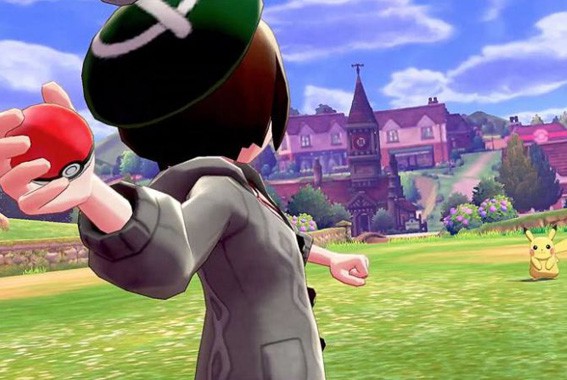Whether you’re a new player who’s experiencing Pokémon for the first time on Nintendo Switch or a hardened veteran eager to check out everything Sword and Shield have to offer, there are a great number of useful tips and tricks to help you get started.
The latest entry in the long-running creature collecting RPG introduces a bunch of new Pokémon to catch, new Dynamax/Gigantamax battle mechanics, version exclusive content, and an exhaustive list of QoL improvements that streamline the series’ notoriously obscure gameplay systems.
In this beginner’s guide, we’ll be sharing everything you need to know before setting off for a new adventure in the Galar region, including tips for picking the right starter Pokémon, catching and battling Pokémon, and leveling up your Pokémon quickly.
Table of ContentsShow
Tips for Picking Your Starter
Picking a starter Pokémon is one of the most important decisions you’ll make in Sword and Shield. The game introduces three new starters—Scorbunny (Fire-type), Sobble (Water-type), and Grookey (Grass-type), which each retain the same typing through to their final evolution. We recommend you go with the one you find most appealing; however, there is room for strategizing if you want to have an easier time in the early goings.
The first three Gyms are Turrfield (Grass-type), Hulbury (Water-type), and Motostoke (Fire-type), so whichever starter you pick will have a chance to shine. Like most Pokémon games, you’re bound to encounter plenty of Grass/Bug Pokémon at the start, giving Scorbunny a slight advantage. However, there are plenty of other factors to consider:
- Type Diversity – What kind of Pokémon do you typically gravitate towards? If you find yourself using a lot of Fire or Water Pokémon, consider picking Grookey to balance things out, or vice versa. A well-rounded team will allow you to take on any challenge with ease of mind.
- Strengths and Weaknesses – Do you prefer training a starter with many or few type disadvantages? As the designated Grass starter, Grookey has the most weaknesses (Fire, Ice, Poison, Flying, Bug), whereas Scorbunny only has three (Water, Ground, Rock) and Sobble two (Electric, Grass). Weigh your options and come up with the best possible choice for your team.
- Looks Can Be Everything – Lastly, we recommend checking out what each starter’s final evolution looks like, as this can be a useful way to steer you in the right direction. It can be a huge letdown to spend countless hours training a Pokémon only to be put off by its final design.
Tips for Catching and Battling Pokémon
Early in the game, you may find yourself encountering some really cool-looking Pokémon that you’ll be immediately tempted to catch. And while the spirit of Pokémon is all about catching them all, chances are you’ll find a better, more powerful version of that very same Pokémon down the road. Therefore, we suggest you keep the following in mind while battling and catching Pokémon in the wild:
- Catch But Don’t Train – It can be appealing to throw a Pokéball at every cute and cuddly creature that crosses your path, so much to the point that you find yourself ending every battle with a new Pokémon in your party. However, unless you plan on investing precious time in training said Pokémon, consider just sending them to your PC for later use.
- Catch Glowing Pokémon – When you’re out in the wild, you may come across Pokémon with a glowing aura surrounding them, indicating they’re more powerful versions of that Pokémon with better stats. Catch these, and you’ll be much closer to crafting the strongest team Galar has ever seen.
- Be Careful Not To Faint Pokémon – It can be easy to accidentally faint a Pokémon you’re trying to catch if you’re not careful, especially weaker ones. Therefore, we recommend teaching your lead Pokémon False Swipe (TM54), which prevents the Pokémon you’re battling from dropping below 1HP.
- Exploit Type Weaknesses/Strengths – Sword and Shield has made learning each Pokémon’s type weaknesses/strengths much easier by indicating whether a move will be effective, super-effective, or not very effective within the move selection menu. If you still find yourself struggling, refer to this type weakness/strength chart.
Tips for Leveling Up and Evolving Pokémon
Leveling up and evolving your Pokémon are two essential ingredients for getting stronger in Sword and Shield, as they allow you to take on stronger Gym Leaders and tougher Pokémon roaming throughout the Wild Area. However, there are some Pokémon that require specific conditions before evolving along with a couple dos and don’ts to keep in mind when leveling up:
- EXP Share Is Your Friend – Sword and Shield sees the return of the EXP Share feature from Gen VII, except now it’s mandatory to use. No need for concern, though, as it’s a handy tool for leveling up Pokémon. Simply place lower level Pokémon you want to train at the bottom of your party and begin reaping the benefits from battles.
- Evolved Pokémon Are Stronger – This may go without saying, but Pokémon, who have already evolved, will outperform Pokémon who haven’t at every turn, regardless of level. Therefore, we recommend evolving your Pokémon as soon as you can, unless you’re holding out for a specific move they learn later on.
- Unique Evolution Conditions – Gone are the days when evolving Pokémon was as simple as raising their level to a certain number. Sword and Shield introduce a ton of new monsters that require the player to complete specific tasks to trigger that Pokémon to evolve. If you’re finding it difficult to evolve a specific Pokémon in Sword and Shield, refer to this useful Galarian evolution chart.
New Features and Changes
Given that Sword and Shield are the first mainline Pokémon games to appear on the Nintendo Switch, there are fundamental differences between the two games and their handheld predecessors. While graphics have naturally been improved, gameplay remains largely unchanged. However, there are a lot of new features and changes that are worth knowing about before you start the game.
AutoSaving
At the start of your journey, you’ll be given the option to turn on autosaving to ensure you don’t lose any progress. This feature is completely new in Sword and Shield and works just like any other game with autosave support. If you prefer manual saving, you can always go into the settings menu to turn autosave off.
Accessing PC Boxes
Sword and Shield removes the PC restriction of previous games by allowing you to access your PC boxes from just about anywhere in the overworld. This means players can swap out Pokémon whenever and wherever they want as well as organize their various boxes. To access your PC, simply navigate to the Pokémon party menu then hit ‘R’ on the joy-con/controller.
Move Reminder
If you want to have a Pokémon remember a move they’ve already learned, then you’re going to have to speak with the move reminder NPC, who now appears in every Pokémon Center. In the past, the player was required to hand over a Heart Scale in exchange for remembering a Pokémon’s move. However, this fee has been removed completely in Sword and Shield, making it much easier and less costly to do so.
Poké Jobs
Every Pokémon game typically introduces at least one new side activity for players to explore outside of standard battling. Sword and Shield has two—Poké Jobs and Poké Camps. In the Galar Region, trainers are able to assign Pokémon to different jobs that grant them XP. This is done by accessing the Poké Jobs tab on the Rotomi PC in any Pokémon Center.
Poké Camps
Poké Camps, on the other hand, can only be accessed while exploring the overworld. These camps allow players to take a break from adventuring and see their Pokémon interact with one another.
While in a camp, Pokémon in your party will run freely and can be entertained with various toys as well as eat curry dishes prepared by the player. Cooking is presented as a mini-game and, depending on the ingredients, can produce a variety of curry dishes that trigger unique effects when consumed.
Dynamax/Gigantamax Pokémon
The biggest and most notable features presented in Sword and Shield are new Dynamax and Gigantamax mechanics, which affect a Pokémon’s appearance and stats. Once your character receives the Dynamax band, you’ll be able to trigger Dynamax transformations during battle, increasing your Pokémon’s size and boosting its stats for three turns.
Gigantamaxing works similarly but does have a few extra benefits. Gigantamax Pokémon will take on a different appearance than Dynamax Pokémon in addition to having their stats boosted even higher and gaining access to super powerful G-max moves. It should be noted that while every Pokémon can Dynamax, only specific Pokémon can Gigantamax.
Version Exclusives
As with previous Pokémon games, Sword and Shield both include a number of exclusive content, including Pokémon only obtainable in one version, exclusive Gym Leaders, and unique Max Raid battle encounters. However, it’s still possible to receive version exclusive Pokémon via trading. Here’s a full list of all the version exclusives:
Pokémon Sword
- Deino, Zweilous, Hydreigon
- Jangmo-o, Hakamo-o, Kommo-o
- Farfetch’d, Sirfetch’d
- Turtonator
- Mawile
- Gothita, Gothorita, Gothitelle
- Rufflet, Braviary
- Sawk
- Seedot, Nuzleaf, Shiftry
- Swirlix, Slurpuff
- Scraggy, Scrafty
- Solrock
- Passimian
- Basculin (Red-stripe)
- Darumaka, Darmanitan
- Flapple
- Stonjourner
- Indeedee (male)
- Gigantamax Machamp (Raid Battle)
- Gigantamax Coalossal (Raid Battle)
- Zacian (Legendary)
- Gym Leader Bea (Fighting-type)
- Gym Leader Gordie (Rock-type)
Pokémon Shield
- Larvitar, Pupitar, Tyranitar
- Goomy, Sliggoo, Goodra
- Galarian Ponyta, Rapidash
- Drampa
- Sableye
- Solosis, Duosion, Reuniclus
- Vullaby, Mandibuzz
- Throh
- Lotad, Lombre, Ludicolo
- Spritzee, Aromatisse
- Croagunk, Toxicroak
- Lunatone
- Oranguru
- Basculin (Blue-stripe)
- Corsola, Cursola
- Appletun
- Eiscue
- Indeedee (female)
- Gigantamax Gengar (Raid Battle)
- Gigantamax Lapras (Raid Battle)
- Zamazenta (Legendary)
- Gym Leader Allister (Ghost-type)
- Gym Leader Melony (Ice-type)




